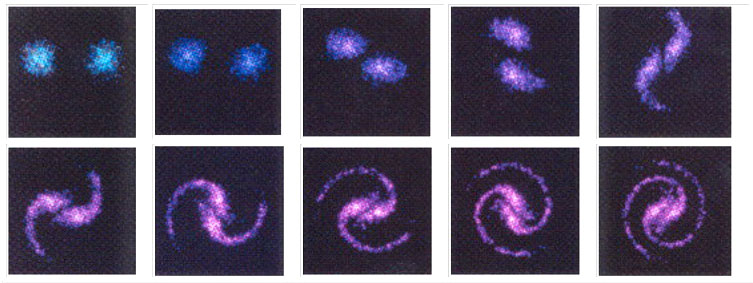
|
Research Areas
At present we have a number of observations to establish the Lambda CDM model as the de facto standard model of cosmology. The fundamental cosmological parameters are now known with uncertainties of only a few per cent, removing a large part of parameter space in galaxy formation studies. While the basic theoretical paradigm appears to be well established, our understanding of the physical processes that lead to the varieties of observed galaxy properties is still far from complete. For better understanding of galaxy formation and evolution, we are actively working on many important areas in this field. Objects like galaxies form when gas condenses at the center of dark matter halos after radiative cooling of baryons. In semi analytic models of galaxy formation we model the evolution, of baryonic components of galaxies, using simple yet physically and observationally motivated prescription. Taking advantage of high resolution N-Body simulations, we specify the location and evolution of dark matter haloes, which are assumed to be the birth places of galaxies. Since pure N-Body simulations like Horizon-Run can handle very large number of particles, this approach can access very large dynamic ranges in mass and spatial resolutions. In addition, the computational costs are limited so that the method allows a fast exploration of the parameter space and an efficient investigation of different specific physical assumptions. In addition to this theoretical modeling of galaxy formation and evolution, we are also investigating galaxy evolution using observational data and through the comparison of them to theoretical models. These days, we are experiencing the boom of extra-galactic data -- both of photometric and spectroscopic -- of a wide redshift range from various galaxy surveys, including the Sloan Digital Sky Survey . Applying various analysis methods -- including Spectral Energy Distribution-fitting methods and comparison to semi-analytic models -- to these vast observational data, we can investigate various physical properties of galaxies and their evolution, as well as the environmental effects on these evolution. We are also actively working on the effects of galaxy interactions on galaxy evolution. Galaxies interact with neighboring galaxies and matter, and are affected by the environment over the course of their lives. In these processes, a variety of phenomena can occur in the involving galaxies such as the morphological changes and enhanced star formation and nuclear activities. We study those effects of interactions on galaxy properties and overall galaxy evolution in the connection to the structure formation theories, by both analyzing observational data, specifically from the SDSS, and performing numerical hydrodynamical simulations. Research Facilities QUEST: a Beowulf-type linux cluster with 64 nodes (256 cores of AMD CPUs) + 512 GB mem. + 20 TB disk GPU: a GPU cluster with 24 nodes (96 Nvidia GPU C2050 cards) + 576 GB mem. + 10 TB disk Myrinet: a Giga-bit device for data communication OpenPBS: a parallel job management tool Software: OpenMPI, MPICH, Portland Group Compiler, CUDA, and, IDL Research Members Changbom Park, Professor Juhan Kim, Research Professor Jeong-Sun Hwang, Research Fellow Jaswant Kumar Yadav, Research Fellow Seong-Kook Lee, Research Fellow Do-Gyun Kim, Graduate Student Research Activities Now all members in this research field at KIAS are currently working in different areas shown above. Jaswant is trying to write a Semi-Analytic code which implements cooling, star formation and feedback on top of the merger trees extractecd from Horizon-Run Simulations. Dr. Lee is studying the SED-fitting method to investigate various physical properties of galaxies and their evolution. Dr. Hwang is dealing with the effects of galaxy interactions on Galaxy evolution with the help of SPH simulations. The interest of other members of the group can be located here. Pictures & Movie Files Fun pictures from the Horizon Run simulations Papers & Press Release Preprints Archive Press Release (Korean) |
|
Korea Insititute for Advanced Study, 207-43 Cheongnyangni 2-dong, Dongdaemun-gu,
Seoul, 130-722, Korea Fax: 82-2-958-3770 |